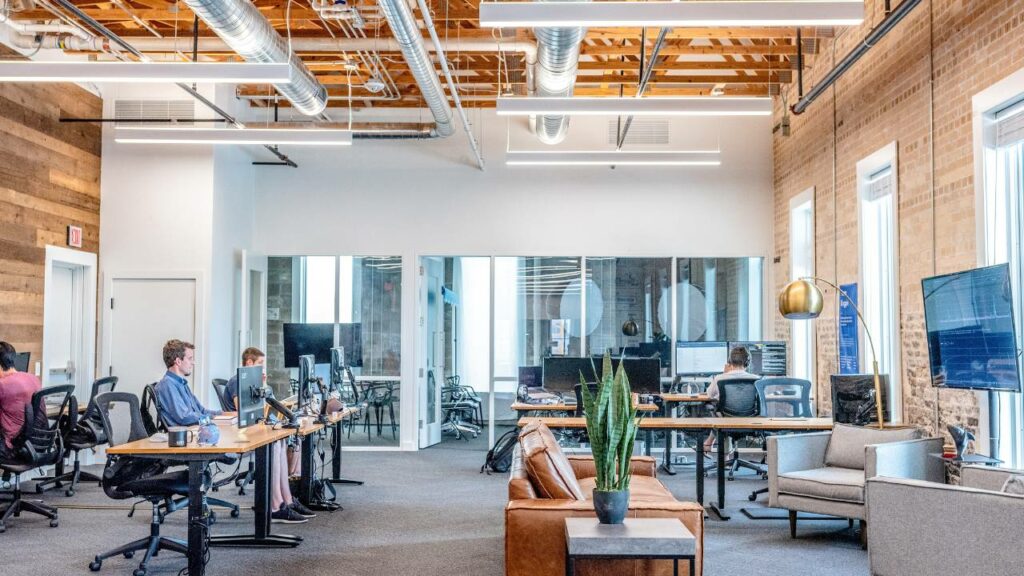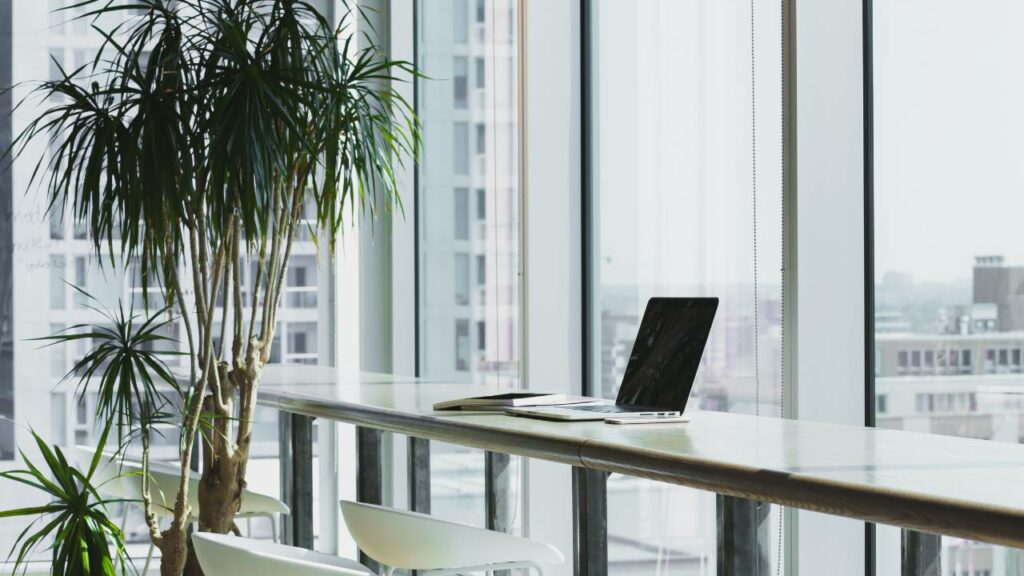The world of business interiors presents unique opportunities for creating a powerful statement in corporate spaces. In recent years, Ireland has seen a surge of interest in designing stylish and functional interiors for businesses. This has led to an increased appreciation for design, sustainability, and the impact of Brexit on Ireland’s interiors industry.
One aspect that sets business interiors apart from residential spaces is the need for a delicate balance of design and functionality. It is crucial to create a professional atmosphere conducive to productivity, whilst simultaneously capturing the essence and branding of the company. In Ireland, designers are taking innovative approaches to strike this balance, incorporating local craftsmanship and materials in their creations.
As a result, the Irish interior design scene is flourishing, with creative minds stepping up to the challenge of designing contemporary business spaces that reflect the rich culture and identity of the Emerald Isle. From incorporating sustainable elements to celebrating Irish brands and craftsmanship, these designs are making a statement and putting Ireland at the forefront of the global business interiors market.
Importance and Growth of Business Interiors in Ireland

The significance of business interiors in Ireland has increased substantially in recent years, as companies recognise the value of creating a strong visual identity. Art and design play crucial roles in establishing functional and aesthetically pleasing working environments. With an expansion in the interiors industry, Irish businesses are embracing innovative design concepts to stand out and make a statement.
An emerging trend in the industry is the use of statement pieces to create eye-catching atmospheres within offices, shops, and commercial spaces. These unique elements enhance brand identity and convey a sense of style and sophistication. Consequently, businesses in Ireland are investing more in art and design, consequently boosting industry growth.
Influences from global concerns, such as climate change, have also shaped the Irish interior design landscape. Businesses are now seeking sustainable design solutions, with eco-friendly materials and energy-efficient practices finding favour among designers. As a result, the demand for vintage and repurposed items has risen, promoting a more environmentally conscious design ethos in the industry.
Another factor contributing to the impressive growth of business interiors in Ireland is the desire to enhance customer experiences. In the retail sector, well-designed shops create inviting, immersive environments that encourage visitors to spend more time browsing and purchasing. By putting a strong emphasis on design, businesses can ensure they flourish in today’s competitive market.
Key Features in Achieving Statement Business Interiors
To create a striking and unforgettable business interior in Ireland, there are several key features to consider. From colours and patterns to functional design, upcycling, affordability, and individual style, these elements work together to produce a remarkable statement.
Careful selection of colours and patterns plays a crucial role in setting the tone for any space. Bold colours have the ability to create a dynamic and energetic environment, whereas subtle and neutral tones exude a sense of calm and sophistication. Patterns can be used to add visual interest and texture, making the interiors feel more engaging and pleasing.
A functional layout is essential in any commercial interior. Ensuring the space is functional for its intended purpose allows employees to work efficiently and comfortably. This includes taking into consideration factors such as lighting, ventilation, ergonomics, and acoustics. A well-designed layout not only creates a productive work environment but also communicates a sense of professionalism to clients and business partners.
Considering upcycling and sustainability in interior design is not only eco-friendly but can also offer a distinctive and unique appearance. Repurposing materials and furniture injects a sense of character and history, making the space more memorable and intriguing. Examples include transforming wooden pallets into benches or finding creative ways to repurpose old lighting fixtures.
Incorporating affordable solutions allows businesses to strike a balance between creating a statement interior and adhering to budget constraints. Investing in key statement pieces, while complementing them with cost-effective, durable options, can help to create an impressive space without breaking the bank. Exploring local markets and suppliers can yield exceptional finds at reasonable prices.
Lastly, personal style should never be overlooked when designing a statement business interior. Each business is unique, and the interior design should reflect the brand’s identity, values, and culture. By incorporating meaningful and representative elements, such as artwork from local artists or displaying awards and achievements, the space will resonate with employees and clients alike.
Process of Creating Statement Business Interiors

The process of creating statement business interiors in Ireland involves a systematic approach that takes into account various factors, including commissions, the local climate, and a commitment to sustainability. Professional interior designers in this field often begin by assessing the needs and preferences of their clients, developing a design concept that reflects the client’s brand and values.
Professional retail shopfitting plays a crucial role in the design process as it involves crafting functional and aesthetically pleasing interiors that align with industry standards and trends. Incorporating statement designs that make a distinct impact, the designer will create a plan that offers visual appeal, enhances employee productivity, and positively influences customer perception.
Text and graphics can be integrated into the overall design, contributing to the business’s identity and message. Typography, colour, and layout should be carefully chosen to establish a visually cohesive space that effectively communicates the brand’s essence and purpose.
With the growing concerns about climate change, the Irish design industry has seen a shift towards eco-friendly practices in developing statement interiors. Green approaches to interior design in Ireland have gained traction over the past few years, reflecting a holistic approach that considers the environment in every aspect of the design process.
One popular eco-friendly approach involves utilising locally-sourced materials, which not only reduces transportation emissions but also contributes to the local economy and supports community businesses. Emphasis on energy efficiency, the use of recycled materials, and waste reduction are other key factors to consider in creating environmentally conscious interiors.
Financial Aspects of Business Interiors in Ireland
The market for business interiors in Ireland has grown significantly, driven by an increasing demand for stylish and functional spaces. The industry is now estimated to be worth millions of Euros, with numerous interior design firms working on projects for offices, restaurants, bars, and hotels.
In terms of VAT, business interior services in Ireland are subject to a standard rate of 23%. However, some services that are tied to new constructions or renovations may qualify for a reduced rate of 13.5%2. It is crucial for interior designers and their clients to understand the applicable VAT rates and ensure compliance with tax regulations.
Interior designers in Ireland commonly work on a commission basis, earning a percentage of the total project cost. This allows them to earn a fair income based on the scale and complexity of their projects. However, it is important for businesses seeking interior design services to be transparent about their budgets and negotiate commission fees accordingly.
The worth of a business interior project can vary greatly, depending on factors such as the size and type of space, the level of detail and customization required, and the chosen design firm. Larger projects, such as hotels or office buildings, may involve more extensive renovations and higher budgets. In contrast, smaller projects, such as one-off office spaces or restaurants, may require more modest investments. It is essential for businesses to carefully consider their needs and budget constraints when selecting an interior design firm and planning their projects.
The success of an interior design company often relies on the leadership and vision of its CEO. In Ireland, many successful firms are led by CEOs who possess a strong background in design, project management, and business networking. These CEOs work diligently to build their companies, attract and retain top talent, and secure lucrative contracts with commercial clients. The financial well-being of the company and the quality of its projects often depend on the leadership skills and strategic mindset of its CEO.
Future Trends in Business Interiors

As the world faces the growing concerns of climate change, it is becoming increasingly important for businesses to adapt and embrace sustainable practices. In addition to standard practices – like shredding paper or choosing eco-friendly packaging – another way to achieve this is through interior design. In the coming years, we can expect to see a significant shift towards eco-friendly and energy-efficient spaces that promote a healthy and sustainable work environment.
A primary focus in future business interiors will be the reduction of emissions and energy consumption. Designers will likely incorporate energy-saving lighting and heating systems, as well as better insulation to conserve energy. Additionally, there will be a greater emphasis on using renewable energy sources, such as solar panels or wind turbines to power interior spaces.
Locally-sourced materials will also play a key role in future interiors, as businesses aim to reduce their carbon footprint and support local economies. By selecting materials, furniture and decorative pieces that are manufactured close to their location, companies can greatly decrease the environmental impact of transporting these items.
Another notable trend in the sphere of business interiors will be the growing importance of biophilic design. Businesses will increasingly incorporate elements of nature in their spaces like indoor gardens, green walls, and water features to promote a stronger connection between the employees and the natural world. This design approach not only fosters a healthier and more productive work environment but also helps address issues related to sustainability and climate change.
The growth of remote working in recent years has also influenced the design of business interiors. Office spaces will need to be more flexible to accommodate different styles of working, and areas for networking, collaboration, and relaxation will become more prominent. A focus on modularity and adaptability, such as movable partitions and furniture, will ensure that the workspace can evolve as the needs of the business change.
Conclusion
The Art of Business Interiors is a growing trend in Ireland, as companies recognise the value of well-designed spaces that make a statement. A thoughtfully designed corporate environment can improve productivity, boost employee morale, and enhance the company’s brand image.
One reason for this trend is the increasing attention to creating spaces that are both functional and aesthetically pleasing. Businesses in Ireland are investing in innovative design solutions to showcase their brand identity and foster a sense of pride among employees. This approach can differentiate a company in a competitive market and attract top talent.
In addition to aesthetics, ergonomic considerations are gaining prominence in the design of corporate spaces. Incorporating elements such as comfortable seating, ample natural light, and optimal acoustics can significantly improve employee well-being and performance. As a result, organisations in Ireland are increasingly collaborating with skilled designers and architects to create spaces that not only look impressive but also support their employees’ needs.
The use of sustainable materials and environmentally friendly practices is another noteworthy aspect of modern business interiors in Ireland. Companies are realising the long-term benefits of incorporating green design principles and are aiming to minimise their negative impact on the environment.
The Art of Business Interiors in Ireland has evolved from a focus on mere functionality to a multidimensional approach encompassing aesthetics, ergonomics, and sustainability. This change reflects a growing awareness of the importance of creating environments that holistically cater to the needs of employees, while at the same time reflecting a company’s brand identity and values – tailoring your workspace for success.


